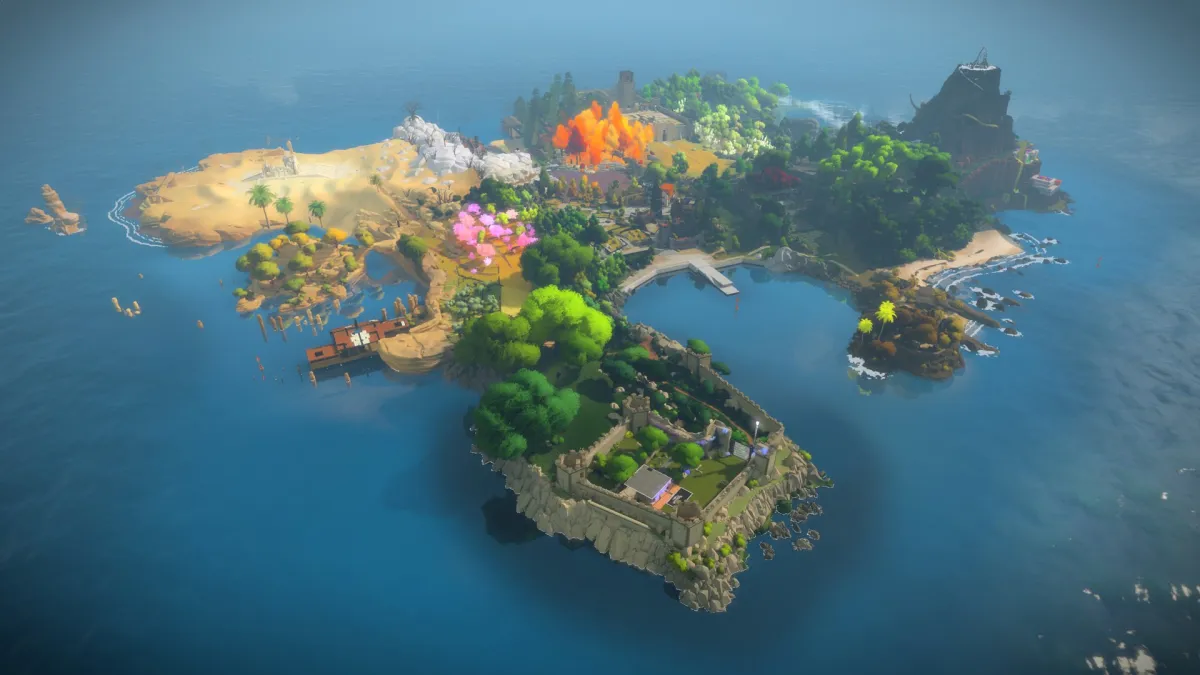Promoted from our Community Blogs
Hi – this is Part 1 of an essay about the game The Witness! This part tries to establish what The Witness is trying to convey, then, I discuss how well the message is communicated.
I’m Sean Han-Tani-Chen-Hogan, and am currently developing the adventure platformer game, Even the Ocean, with a friend, Joni Kittaka. We also made the game Anodyne.
Spoilers from here on out!
I’ve spent around 24 hours in The Witness, stopping after the Platinum trophy. I streamed my entire playthrough. I didn’t fill up the obelisks. It was fun!
But, enough about me. The three parts of my essay are:
- The Witness‘s message
- The popular perception and influence of The Witness
- The drawbacks of singular vision games
The first part is mentioned above.
The second brings up how the way we discuss and perceive The Witness has been warped by the hype and media portrayal of the game and its primary creator.
The third talks about downsides of other games with creators with singular visions, and how they can lead to fans and the media constructing ‘genius narratives.’
I will post each part separately over the coming days – this is just Part 1!
Part 1: The Witness’s Message

Endings and Conflicting Ideas
The game uses audio logs, videos, and gameplay to present quotes and visual cues for contemplation, often about the process of learning, Zen, and connections of religion and science. These ideas are contradictory at times: we might be solving some logical puzzles, and then, we are listening to an audio log that tells us about Zen and the value of asking unanswerable questions. Some videos condemn Art and value Science, yet the detail in the architecture and the portrayal of nature in The Witness – the way we learn about the spaces in the game through our footstep noises – seems to value Art.
The Witness comes off as contradictory, but much of this feels intentional with the context of the endings and some post-game secrets.
As I’ll mention later – other games, such as Undertale, and my own Anodyne – leave some content at the end, that only a few players will see. This content tends to help a player re-contextualize their experience with the game towards a reading more in line with the creators’ intention. A player’s reading is just as important as what the creator intended, and there is no correct meaning. But creators should be wary that if they do have something to say, they should opt for being clear.
I consider The Witness‘s three “endings” to mean the cage ending, the wake-up ending, and the hour-long Psalm 46 video.
The game, in the third ending – a video recording of the talk, Psalm 46 – has a theme saying that the phenomenon of digging for secrets goes back forever, yet history shows that this compulsion can easily lead us down to dead ends we may never realize we’re in.
You get this video at the end of a timed, secret gauntlet of randomized puzzles. It might be the last big secret you find. The Witness is saying: “I am just a game, and I have no Truths, so don’t worry about digging through all of my nooks and crannies.”
In addition to the third, the game’s first ending (0:00) takes place after solving puzzles in a surreal area that references the game’s development: sketches of the island adorn the walls, some rooms look like offices, piles of monitors are stacked here and there.
At the end, it leads you into a cage, and takes you to the beginning tunnel of the game, resetting the island’s puzzles. A rather literal way of saying that the value of The Witness is in the journey, not the end – that figuring out these puzzles doesn’t give a single concrete Truth.
In a second ending (14:00), at the end of an Easter Egg room, a video made with a GoPro plays where a person ‘wakes up’ from the game, taking off electrodes, then walking around The Witness‘s development office, trying to find patterns in the environment representing the game’s circle and line puzzles. This ending says that what’s important isn’t the ‘meaning’ of the puzzles, but what one can take outside of the game into real life.
Roughly, the themes of the three endings are (1) – Don’t get caught in cycles of insular thought, (2) – Try to abstract and use lessons in real life, and (3) – Digging for secrets likely has diminishing returns and can also be dangerous for mental well-being.
The game finally self-references itself in a hidden, post-game audio log, asking the player to keep in mind that this game was made by humans and not meant to aspire towards Truth.
“Because if we get too concerned, with saying a bunch of wise things in the least personally-revealing way, then we’re basically putting up a front, in danger of becoming a false front.
It’s a slippery slope, and you know how easily we could slide into pomposity.
[…]
We’re human beings who lack perfection. We have problems. These recordings are part of an endeavor, built by human beings, and they aspire to Truth-with-a-capital-T, but we must also remember that they cannot actually get there. We should be clear to the intrepid that we know this. It’ll make it all better!”
What The Witness Argues

So, okay. The game wants to argue that:
- There is value in stepping back from problems and taking a break.
- What a player gets from The Witness shouldn’t be about pursuing some concrete answer.
- The Witness does not have any big “Truths,” and those “Truths” don’t exist anywhere.
- The Witness is a place to find objects of contemplation, and take them out into ‘the real world’ to think about and find small Zen-like epiphanies with.
However, it’s a weak attempt at communication. To the people who don’t get that far, the game appears to argue that by the use of reason and deduction, we can easily improve ourselves and advance towards Truth. I would say the first point there is the strongest argued point in the game, since it is often a useful puzzle-solving technique.
The Witness presents a sincere philosophy, one detached from the social realities of the 2010s, only really digging into a history as it pertains to science, Zen, and some philosophers and mathematicians. It is a philosophy that sounds universal.
It’s nice that in the audio log the game acknowledges it isn’t trying to be perfect. But it sure seems like it was trying to be – and a single audio log can’t counteract what the entire game has represented up to that point, which is extremely orderly and heavily-designed environments and puzzles, with some conflicting ideas floating around.
Even knowing these things, it doesn’t feel profound, or particularly useful, because – even as we “wake up” and “leave” The Witness, and we have learned this abstract idea of “walking away from things to contemplate” – like we did for learning and conquering many of the games’ puzzles, when I go into reality and think about these ideas by themselves – they are not that helpful. What is it supposed to mean? Self-control? Patience? These are virtues many artworks and life experiences can teach.
The Witness‘s philosophy operates in this world of abstractions away from the day-to-day realities of people and the material problems they face in making a living, facing violence and other problems.
The Witness tries to be neutral, by making statements that it thinks should apply to everyone, anywhere. It puts too much focus on the individual as a source of self-initiated change that then bubbles up to the world, rather than any focus on the systems we live in and how they can be modified to then change us.
On Human Drama

Let’s look at another quote from that audio log:
“Yes, but you can find human drama anywhere.
We’re drowning in it from day to day.
We’re supposed to be building a quiet environment, -away- from drama, not… celebrating it.
Look. These are objects of contemplation. These are about focus and clarity. We agreed at the outset.”
You can find the whole log under ‘authenticity’ here. The game thinks that we are ‘drowning’ in ‘human drama’ – which explains why, despite the light narrative pervading the island, and the personality of its creators being tangible while playing, many of its statements come off as universalizing. The game doesn’t want to be too explicit about day-to-day things – it wants to create a place for contemplation, and thinks that too much of the creator’s thoughts might sully the island.
By not being explicit, The Witness makes it harder to tie its universalizing statements to real life. What we have are two layers of Understanding in The Witness: an outer layer of enjoying the puzzles but feeling this sense of being controlled by the game, and an inner layer where we understand what the game is trying to communicate through its endings and post-game.
I think when we view the inner layer, it feels weak. The game tries to find these inoffensive, neutral ideas that we should follow, and then stops its discussion there.
But what the game does with the act of observation, the act of learning its puzzles’ rules, etc… I feel like that could have been related to what the game calls “human drama” more, and the game would have been better off for it.
After playing The Witness, I did feel like I was formally observing my real-life environment more. But without any other context for that action, I wasn’t doing much more than really seeing how light and shadows mixed. I wish The Witness had grounded itself and taken a stand in social reality.
By saying that it can create a focused, clear, contemplative space, The Witness forgets that everything, as I’ll show, can be drawn back to the creator. The intended neutrality of the island is biased because it had a human creator who believed such an island to be neutral – thus this space for contemplation is biased towards the ideals within the creators head.
The expressiveness of The Witness

This lack of attachment to social reality extends throughout the game’s environments. In an essay from Understanding a Photograph, the art critic John Berger talks about how photographs can exist on a spectrum of expressiveness. A photo shows an instant of time, and depending on the photo, we can or cannot trace the events leading up to and after the photo. A photo, then, is ‘not expressive’ if we can’t deduce anything about the events preceding or coming after it. An example is a man standing next to a horse. Or a picture of sun falling through tree branches. There is just no context: at best, we can guess. It’s hard to learn much outside of the seconds, or minutes, before or after the moments.
(Of course, we can still deduce things about horses and people in general, etc., it is just that when you can figure out this little ‘radius of time’ around a photo, it helps us learn a lot more.)
The world of The Witness is not very expressive, in Berger’s definition. While the island, in itself, has an architectural history, if we take any photo of it to an outside viewer unfamiliar with the game, it’s just visual pleasure. A person familiar with The Witness would be able to tell what puzzles have been finished (or consumed!), what areas you have seen.
There is no in-game social context for the island’s ruins or overgrown places; time isn’t really passing except for when we modify puzzles or elements in the game world. Yes, some photos tell us someone used to live here, or that people got stone from here or there. The island has a history, but even piecing it together doesn’t say much. It feels like some ‘period rooms’ in museums – recreations of rooms from history – very accurate visually, yet missing that social context to really lend meaning to what an era was like.
In The Witness, if you trace something like a bench near the sea, and think of what past that bench came from, that past exists only in the game’s world – and has no real connection to our world – it’s just a set of meticulously constructed ideas that look beautiful, yet are empty.
In short, what we can really trace all happens to be traced back to faint levels of human drama around the island’s creator. A sense that the game was created by a ‘genius’ – a dangerous term, as I will soon discuss.
In Part 2, I argue that because of the game’s cultural power and hype around it, The Witness has a responsibility to do more to engage its philosophy with the social structures and systems of our world.
Thanks for reading this far! If you like my writing, you can find more over at Medium. If you’re interested in my games, check out my current one, Even the Ocean, a longform, narrative-driven adventure platformer coming out summer 2016.




